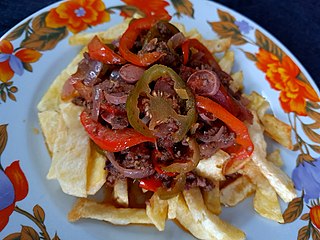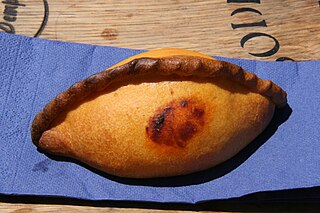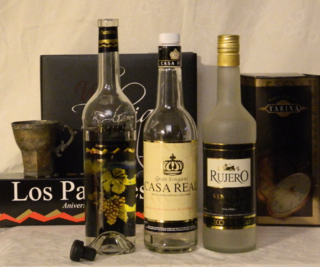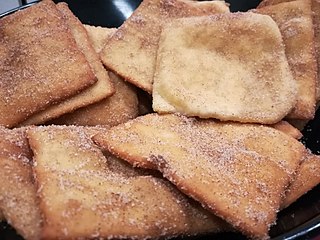 W
WBolivian cuisine stems from the combination of Spanish cuisine with indigenous ingredients and Aymara traditions, among others, with later influences from Germans, Italians, French, and Arabs due to the arrival of immigrants from those countries. The traditional staples of Bolivian cuisine are corn, potatoes, quinoa and beans. These ingredients have been combined with a number of staples brought by the Spanish, such as rice, wheat, and meat, including beef, pork, and chicken.
 W
WAjí is a spicy sauce that often contains tomatoes, cilantro (coriander), ají pepper, onions, and water.
 W
WAn alfajor or alajú is a traditional confection found in Argentina, Bolivia, Chile, Colombia, Ecuador, Paraguay, Peru, the Philippines, Southern Brazil, Southern France, Spain, Uruguay, and Venezuela. The archetypal alfajor entered Iberia during the period of al-Andalus. It is produced in the form of a small cylinder and is sold either individually or in boxes containing several pieces.
 W
WThe batán is a kitchen utensil used to process different kinds of foods in South American and Andean cuisine. It has a flat stone and a grinding stone called an uña. The uña is held in both hands and rocked over the food in the batán. Depending on the process wished, the uña's weight is slightly held back, let loose over, or pressed on. The rocking movements also vary depending on the procedure. The grinding is done dry or with water or oil. The batán has been used since before the arrival of Spaniards in South America.
 W
WA buñuelo is a fried dough fritter found in Spain, Latin America, Israel, and other regions with a historical connection to Spaniards or Sephardic Jews, including Southwest Europe, the Balkans, Anatolia, and other parts of Asia and North Africa. Buñuelos are traditionally prepared at Christmas, Ramadan, and among Sephardic Jews at Hanukkah. It will usually have a filling or a topping. In Mexican cuisine, it is often served with a syrup made with piloncillo.
 W
WCapsicum baccatum is a member of the genus Capsicum, and is one of the five domesticated chili pepper species. The fruit tends to be very pungent, and registers 30,000 to 50,000 on the Scoville Heat Unit scale.
 W
WChancaca is a typical Peruvian, Bolivian, and Chilean warm, sweet sauce made of raw unrefined sugar from sugarcane. It is often flavored with orange peel and cinnamon, and is consumed on sopaipillas or picarones.
 W
WChicha is a fermented (alcoholic) or non-fermented beverage of Latin America, emerging from the Andes and Amazonia regions. In both the pre- and post-Spanish conquest periods, corn beer made from a variety of maize landraces has been the most common form of chicha. However, chicha is also made from a variety of other cultigens and wild plants, including, among others, quinoa, kañiwa, peanut, manioc, palm fruit, rice, potato, oca, and chañar. There are many regional variations of chicha. In the Inca Empire, chicha had ceremonial and ritual uses.
 W
WChicharrón is a dish generally consisting of fried pork belly or fried pork rinds. Chicharrón may also be made from chicken, mutton or beef.
 W
WChifles, fried plantain chips, are a side dish, snack food, or finger food of Ecuador, Thailand and northern Perú.
 W
WChuflay is the name of a traditional Bolivian mixed drink. The drink is made on the rocks in a tall glass, such as a Collins glass, with a jigger of singani and filled with either ginger ale, 7-Up, or Sprite and often garnished with a slice of lime. Chuflay is used in special events, i.e. weddings, promotions, amongst others. This drink is very affordable in most places and is served frequently.
 W
WChuño is a freeze-dried potato product traditionally made by Quechua and Aymara communities of Bolivia and Peru, and is known in various countries of South America, including Bolivia, Peru, Chile and Northwest Argentina. It is a five-day process, obtained by exposing a bitter, frost-resistant variety of potatoes to the very low night temperatures of the Andean Altiplano, freezing them, and subsequently exposing them to the intense sunlight of the day. The word comes from Quechua ch'uñu, meaning 'frozen potato'.
 W
WChurrasco is the Portuguese and Spanish name for beef or grilled meat more generally. It is a prominent feature in the cuisine of Brazil, Uruguay and Argentina. The related term churrascaria is mostly understood to be a steakhouse.
 W
WA churro is a type of fried dough from Spanish and Portuguese cuisine. They are also found in Latin American cuisine and the cuisine of the Philippines and in other areas that have received immigration from Spanish and Portuguese-speaking countries, especially in the Southwestern United States and France.
 W
WThe guinea pig or domestic guinea pig, also known as the cavy or domestic cavy, is a species of rodent belonging to the genus Cavia in the family Caviidae. Breeders tend to use the word cavy to describe the animal, while in scientific and laboratory contexts, it is far more commonly referred to by the common name guinea pig. Despite their common name, guinea pigs are not native to Guinea, nor are they closely related biologically to pigs, and the origin of the name is still unclear. They originated in the Andes of South America. Studies based on biochemistry and hybridization suggest they are domesticated animals that do not exist naturally in the wild, descendants of a closely related cavy species such as C. tschudii. They were originally domesticated as livestock for a source of meat, and are still consumed in some parts of the world.
 W
WHallulla is a popular bread in Chile and Bolivia. The hallulla is a flat round bread baked with vegetable shortening and is used for several traditional sandwiches. A typical white hallulla is similar in taste and texture to a scone, but is circular and larger, and more often used with savoury rather than sweet fillings.
 W
WHumita is a Native South American dish from pre-Hispanic times, a traditional food from the Andes and it can be found in Bolivia, Chile, Ecuador, Peru, and Northwest Argentina. It consists of fresh choclo pounded to a paste, wrapped in a fresh corn husk, and slowly steamed or boiled in a pot of water. In Bolivia it is known as huminta and in Brazil as pamonha. Humitas are similar to Mexican uchepos, which are also made with fresh corn; but they are only superficially similar to tamales, which are made with nixtamalized corn (masa).
 W
WLlajua or llajwa is a Bolivian chili sauce prepared from locotos hot chili peppers, and tomatoes; sometimes onions are added to the mix. One or two seasoning herbs could be added, depending on the region and taste: quillquiña in Cochabamba and wakataya in the Altiplano and other valleys of Bolivia. It is preferably prepared on a grinding stone called a batán, which can be found in most Bolivian households of Cochabamba and Altiplano. In the absence of a batan, it can be prepared in a blender.
 W
WLocro is a hearty thick squash stew, associated with Native Andean civilizations, and popular along the Andes mountain range. It's one of the national dishes of Peru, Bolivia, Ecuador, Chile, Paraguay and Northwest Argentina.
 W
WMáchica is a type of flour made from ground toasted barley or other toasted grains. It is used in Bolivian, Ecuadorian and Peruvian cuisine.
 W
WA Portuguese roll, also known as a Marraqueta, pão francês, and other names, is a bread roll made with wheat flour, salt, water and yeast. This type of roll has a crunchy texture, and is very popular in South America, and also Portugal, Mallorca, Hong Kong and Macau.
 W
WThe milanesa is a South American variation of Italian cotoletta, or schnitzel, where generic types of meat breaded cutlet preparations are known as a milanesa.
 W
WMocochinchi is a Bolivian beverage. It is made with peaches that have been peeled and dried. The fruits are left in water overnight, then boiled with sugar and cinnamon. The drink is served cold, and often, after finishing the drink, the peach is eaten.
 W
WMote is the generic name for several varieties of boiled grains, consumed in many regions of South America. It is usually prepared by boiling the grains in water made alkaline by the addition of ashes or lime, a process known as nixtamalization.
 W
WPapas rellenas are the most popular type of croquettes in Latin American regions such as Ecuador, Bolivia, Peru, Chile, Colombia, & the Caribbean. The first recorded Latin American recipes were printed in the late 19th century, during a time when French cuisine was influencing those of Latin America.
 W
WPique macho or Pique a lo macho is a typical Bolivian food. It is a heaped plate consisting of bite-sized pieces of beef, and french fry-cut potatoes. Added to this mixture are onions, locoto, boiled egg, mustard, mayonnaise, and ketchup.
 W
WA salteña is a type of baked empanada from Bolivia.
 W
WSilpancho is a popular Bolivian food from the city of Cochabamba. When prepared properly, this tends to be a large and fulfilling meal with a diversity of carbohydrates and fats. It consists of a base layer of rice, usually white, followed by a layer of boiled and sliced potatoes. Next, a thin layer of pounded meat is followed by a layer of chopped tomato. In addition, onion, beet and parsley are mixed together and topped with either one or two fried eggs.
 W
WSingani is a Bolivian eau-de-vie or brandy distilled from white Muscat of Alexandria grapes. Only produced in the high valleys of Bolivia, it is the country's national distilled spirit and considered part of its cultural patrimony.
 W
WA sopaipilla, sopapilla, sopaipa, or cachanga is a kind of fried pastry and a type of quick bread served in several regions with Spanish heritage in the Americas. The word sopaipilla is the diminutive of sopaipa, a word that entered Spanish from the Mozarabic language of Al-Andalus. The original Mozarabic word Xopaipa was used to mean bread soaked in oil. The word is derived in turn from the Germanic word suppa, which meant bread soaked in liquid.
 W
WTrancapecho is a sandwich served in Cochabamba, Bolivia. It comes from a dish called "silpancho", which differs from the traditional silpancho. All ingredients, including the rice, join to a bread tortilla, also the typical preparation in this city. In Cochabamba, this sandwich is found in areas such as markets and areas near San Paul's Catholic University.